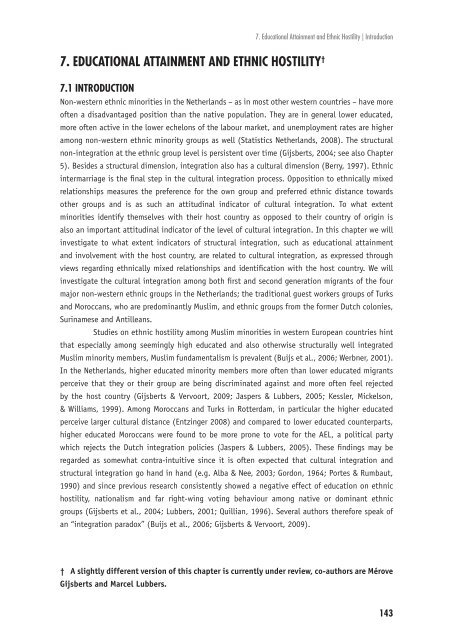Ethnic Hostility among Ethnic Majority and Minority Groups
Ethnic Hostility among Ethnic Majority and Minority Groups
Ethnic Hostility among Ethnic Majority and Minority Groups
You also want an ePaper? Increase the reach of your titles
YUMPU automatically turns print PDFs into web optimized ePapers that Google loves.
7. EDUCATIONAL ATTAINMENT AND ETHNIC HOSTILITY †<br />
7.1 INTRODUCTION<br />
7. Educational Attainment <strong>and</strong> <strong>Ethnic</strong> <strong>Hostility</strong> | Introduction<br />
Non-western ethnic minorities in the Netherl<strong>and</strong>s – as in most other western countries – have more<br />
often a disadvantaged position than the native population. They are in general lower educated,<br />
more often active in the lower echelons of the labour market, <strong>and</strong> unemployment rates are higher<br />
<strong>among</strong> non-western ethnic minority groups as well (Statistics Netherl<strong>and</strong>s, 2008). The structural<br />
non-integration at the ethnic group level is persistent over time (Gijsberts, 2004; see also Chapter<br />
5). Besides a structural dimension, integration also has a cultural dimension (Berry, 1997). <strong>Ethnic</strong><br />
intermarriage is the fi nal step in the cultural integration process. Opposition to ethnically mixed<br />
relationships measures the preference for the own group <strong>and</strong> preferred ethnic distance towards<br />
other groups <strong>and</strong> is as such an attitudinal indicator of cultural integration. To what extent<br />
minorities identify themselves with their host country as opposed to their country of origin is<br />
also an important attitudinal indicator of the level of cultural integration. In this chapter we will<br />
investigate to what extent indicators of structural integration, such as educational attainment<br />
<strong>and</strong> involvement with the host country, are related to cultural integration, as expressed through<br />
views regarding ethnically mixed relationships <strong>and</strong> identifi cation with the host country. We will<br />
investigate the cultural integration <strong>among</strong> both fi rst <strong>and</strong> second generation migrants of the four<br />
major non-western ethnic groups in the Netherl<strong>and</strong>s; the traditional guest workers groups of Turks<br />
<strong>and</strong> Moroccans, who are predominantly Muslim, <strong>and</strong> ethnic groups from the former Dutch colonies,<br />
Surinamese <strong>and</strong> Antilleans.<br />
Studies on ethnic hostility <strong>among</strong> Muslim minorities in western European countries hint<br />
that especially <strong>among</strong> seemingly high educated <strong>and</strong> also otherwise structurally well integrated<br />
Muslim minority members, Muslim fundamentalism is prevalent (Buijs et al., 2006; Werbner, 2001).<br />
In the Netherl<strong>and</strong>s, higher educated minority members more often than lower educated migrants<br />
perceive that they or their group are being discriminated against <strong>and</strong> more often feel rejected<br />
by the host country (Gijsberts & Vervoort, 2009; Jaspers & Lubbers, 2005; Kessler, Mickelson,<br />
& Williams, 1999). Among Moroccans <strong>and</strong> Turks in Rotterdam, in particular the higher educated<br />
perceive larger cultural distance (Entzinger 2008) <strong>and</strong> compared to lower educated counterparts,<br />
higher educated Moroccans were found to be more prone to vote for the AEL, a political party<br />
which rejects the Dutch integration policies (Jaspers & Lubbers, 2005). These fi ndings may be<br />
regarded as somewhat contra-intuitive since it is often expected that cultural integration <strong>and</strong><br />
structural integration go h<strong>and</strong> in h<strong>and</strong> (e.g. Alba & Nee, 2003; Gordon, 1964; Portes & Rumbaut,<br />
1990) <strong>and</strong> since previous research consistently showed a negative effect of education on ethnic<br />
hostility, nationalism <strong>and</strong> far right-wing voting behaviour <strong>among</strong> native or dominant ethnic<br />
groups (Gijsberts et al., 2004; Lubbers, 2001; Quillian, 1996). Several authors therefore speak of<br />
an “integration paradox” (Buijs et al., 2006; Gijsberts & Vervoort, 2009).<br />
† A slightly different version of this chapter is currently under review, co-authors are Mérove<br />
Gijsberts <strong>and</strong> Marcel Lubbers.<br />
143












